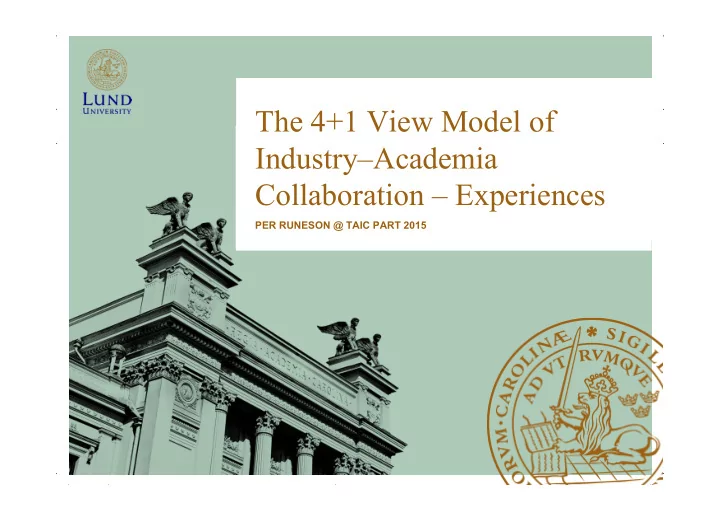

The 4+1 View Model of Industry–Academia Collaboration – Experiences PER RUNESON @ TAIC PART 2015
It takes two to tango T esting: Academic & Industrial C onference Practice a nd Research T echniques
Industry-academia anti-patterns 1. academia always behind 2. research then transfer 3. research on demand 4. the blame game
The 4+1 Model [RUNESON & MINÖR, 2014]
The 4+1 View Model of Architecture PHlLlPPE B. KRUCHTEN, Rational Software *Th 4+1 ViewMOdel turely partitioning the software or e all have seen . . - overemphasizing one aspect of devel- many-books and-articles in which a organizes a description of a opment (like data engineering or run- single diagram attempts to capture the time efficiency), development strategy, sojiware architecture using Jive gist of a system architecture. But when or team organization. Other software you look carefully at the diagram’s conmwent views, each of which architectures fail to address the con- boxes and arrows, it becomes clear that cerns of all “customers.” Several authors have noted the ” Architeas capture their design Do the boxes represent running pro- problem of architectural representa- grams? Chunks of source code? tion, including David Garlan and decision5 in four views and use Physical computers? Or merely logical Mary Shaw,’ Gregory Abowd and Robert Allen,’ and Paul C1ements.j t,r,e~fih vim to illustrate groupings of functionality? Do the and The 4 + 1 View Model was devel- arrows represent compilation depen- validate them. dencies? Control flows? Dataflows? oped to remedy the problem. The 4 + Usually the answer is that they repre- 1 model describes software architec- sent a bit of everything. ture using five concurrent views. As Does an architecture need a single Figure 1 shows, each addresses a spe- architectural style? Sometimes the cific set of concerns of interest to dif- software architecture suffers from sys- ferent stakeholders in the system. + T h e logical view describes the tem designers who go too far, prema- Authorized licensed use limited to: IEEE Xplore. Downloaded on December 07,2010 at 15:58:10 UTC from IEEE Xplore. Restrictions apply.
4+1 model of industry-academia collaboration 1. Time view (when) 2. Space view (where) 3. Activity view (how) 4. Domain view (what) + 1 use case view – collaboration scenario
Knowledge cycles Career 40 years Paradigm shift 20 years Research program 10 years Education program 5 years Company operations 1 years Knowledge
Time horizons Table 1: Typical time horizons in industry–academia collaboration (years) Area Industry Academia Contracts 1 – 3 3 – 5 Goals 1/4 – 3 3 – 5 Results 0 – 3 3 – 10 Organization 1 – 3 5 – 10 Work practice 0 – 1/2 0 – 3
Doomed to fail?
Time view (when) Time frame Best practice now Next soon practice Applied 3-5 years research Basic 5+ years research
Time practicalities Researchers make commitments far ahead of time for e.g. conference organization and teaching, while industry staff re-plan their commitments on daily, or even hourly basis, for higher management. [Runeson 2012]
Space distances
Space view (where) World Europe North East West Sweden Baltic South Øresund
Traveling CC David Cosand @ flickr Why does space matter? Collaboration involves meetings = traveling: Local – almost no traveling time Regional – traveling time of 1-2 hours, i.e. a meeting takes at least half a day National – traveling of 2+ hours, i.e. any meeting takes a full day International – traveling takes more than one day
There are other distances… • Geographical • Organizational • Psychological • Cognitive • Adherence • Semantic • Navigational • Temporal CC Rennett Stowe @ flickr [Bjarnason et al 2015]
Organizational issues Long term Top Commit mgmt view Manage Devlpmnt Research Time to Conduct Practition Practition Research spend
Domain view (What) Industrial Automation Automotive Telecom Mobile Defense Public Other Medical Software Management Software Engineering Software Technology
Industry: Silos —> Cross domain CC Miroslav Petrasko @ flickr
Activity view (how) Activities Networking Catalyzing Executing Society/Financing Actors Knowledge Provider Service Provider Product Provider
Industry-academia win-win � Case study … investigate one instance … of a contemporary software engineering phenomenon within its real-life context , especially when the boundary between phenomenon and context cannot be clearly specified
+1
when where what how
Example: Industrial Excellence Center on Embedded Applications Software Engineering when where what how
” Buth what…it is good for ” Engineer at Advanced Computing Systems Division of IBM, 1968 • Negotiating new collaboration – Setting expectations right • Analyzing ongoing collaboration – Understanding success & failure • Identifying missing collaboration – Improving for the future
What did we learn? Time – the need for long term relations, the acceptance of different time scales Space – physical distance plays a role also in the digital world Activity – the collaboration may include several kinds of activity for mutual benefit Domain – industries in different domains may learn from each other, catalyzed by academic research
Bibliography E. Bjarnason, K. Smolander, E. Engström, and P. Runeson. A theory of distances in software development. Information and Software Technology , To appear, 2015. T. Gorschek, P. Garre, S. Larsson and C. Wohlin, A Model for Technology Transfer in Practice, IEEE Software , Issue November/December, pp. 88-95, 2006. P. Runeson. It takes two to tango – an experience report on industry–academia collaboration. TAIC-PART , pp. 872–877, 2012. (Best paper award) P. Runeson and S. Minör. The 4+1 view model of industry–academia collaboration. Intl. Workshop on Long-term Industrial Collaboration on Software Engineering (WISE) . ACM, 2014. P. Runeson, S. Minör, and J. Svenér. Get the cogs in synch – time horizon aspects of industry–academia collaboration. Intl. Workshop on Long-term Industrial Collaboration on Software Engineering (WISE) . ACM, 2014. A. Sandberg, L. Pareto, and T. Arts. Agile collaborative research: Action principles for industry-academia collaboration. IEEE Software, 28(4):74–83, 2011. C. Wohlin, Empirical Software Engineering Research with Industry: Top 10 Challenges, 1 st Int’l Workshop on Conducting Empirical Studies in Industry (CESI 2013) - An ICSE 2013 Workshop, pp. 43-46, 2013.
Recommend
More recommend